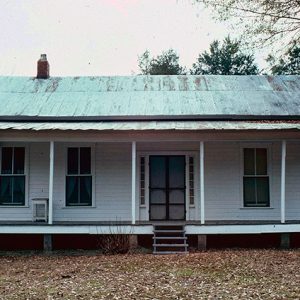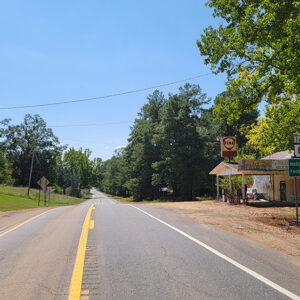calsfoundation@cals.org
Princeton (Dallas County)
A once thriving town, Princeton had become a small community with a population of only thirteen by the 2020 federal census. Although it was the first seat of Dallas County, the town was supplanted by Fordyce (Dallas County) as the leading community in the county in the early twentieth century.
Founded in 1845, Dallas County was formed from Clark and Bradley counties. The site for the town was selected later that year, and work began on a courthouse. An early name for the community was Dallastown. Winthrop Colbath received a federal land patent for the area that would become Princeton on July 10, 1848. The eighty-acre plot was divided into smaller lots and sold. Several public structures were built in addition to the courthouse, including a jail in 1848 and a public well in 1851. The town included a public square and a post office that opened in 1845. By 1850, the town had four doctors and a dentist. Other businesses included tailors, wagon makers, and pottery kilns. Baptist, Methodist, and Presbyterian churches served the community.
The Princeton area included a mixture of large plantations and smaller farms in the decade before the Civil War. The 1860 census listed 4,788 white residents with 3,495 enslaved people in the county, along with a single free person of color. Hundreds of men from the surrounding area joined the Confederate army, making up companies that served in the Eighteenth and Thirty-seventh Arkansas Infantry Regiments and the Third Arkansas Cavalry, as well as other units, such as Company C of the Sixth Arkansas Infantry.
The war did not directly impact the Princeton area until the capture of Little Rock (Pulaski County) by Federal troops in September 1863. Confederate forces evacuated to the south, and some units passed through Princeton. A skirmish was fought near the community on December 8, 1863.
During the Camden Expedition, both Federal and Confederate forces passed through the settlement. Major General Frederick Steele led his forces from Camden (Ouachita County) through Princeton in an effort to return to Little Rock before Confederate forces could arrive to attack. A small skirmish was fought near the town on April 28, 1864, as Confederate cavalry tried to locate the Federals. While pursuing Steele’s retreating forces, Walker’s Texas Division marched through the town and received a warm welcome from the women and children who lined the route. The Engagement at Jenkins’ Ferry, fought about fourteen miles north of Princeton, brought hundreds of casualties to the town as several buildings were turned into hospitals to care for the men.
Early settlers in Princeton used tutors for the education of their children and sent older students to attend school in other nearby towns, including Tulip (Dallas County). Located about eight miles north of Princeton, Tulip supported several educational institutions including the Arkansas Military Institute and the Tulip Female Collegiate Seminary. Public school instruction began in the community in 1874. A new school building was constructed in 1898 and utilized until 1936 when a Works Progress Administration–constructed building opened. Nearby school districts at Ramsey (Dallas County), Midway (Dallas County), and Eaglette (Dallas County) all consolidated with the Princeton District between 1930 and 1941. The Princeton District consolidated with the Fordyce District in 1965, while a small portion of the district consolidated with the Sparkman (Dallas County) District.
The decline of the community began in 1882 with the establishment of what would become the Cotton Belt Railroad through the southeastern corner of the county. Fordyce was formed and quickly grew due to its location on the railroad. This led to the transfer of the county seat from Princeton to Fordyce in 1908. Princeton did receive rail service but only supported lines that fed timber mills.
Historic sites near the community include the remains of several pottery kilns. The Culbertson Kiln and the Bird Kiln are both located near Princeton and are listed on the National Register of Historic Places. The Princeton Cemetery is located southeast of the community and includes graves dating to 1849. The cemetery includes the marked graves of several Confederate soldiers who died during the Camden Expedition or from wounds received at Jenkins’ Ferry. A marker for unknown soldiers is also included in the cemetery. The cemetery continues to be utilized for new burials in the twenty-first century.
The post office in Princeton closed in 1967, with coverage being taken up by the office in Carthage (Dallas County). No businesses operate in Princeton. A station of the Tulip-Princeton Volunteer Fire Department is located in the community, as well as an office for the Arkansas Forestry Commission. The population of Princeton and the surrounding Princeton Township has continued to decrease over the decades. The township population was listed at 359 in 1960 and fell to 252 by 1980. In 2020, the township population included ninety-five residents, with thirteen living within the boundaries of the census-designated location of Princeton.
For additional information:
Bearss, Edwin C. Steele’s Retreat from Camden and the Battle of Jenkins’ Ferry. Little Rock: Arkansas Civil War Centennial Commission, 1967.
Biographical and Historical Memoirs of Southern Arkansas. Chicago: Goodspeed Publishing Co., 1890.
Dallas County Museum. http://www.dallascountymuseum.org (accessed January 5, 2024).
Moneyhon, Carl, ed. “Life in Confederate Arkansas: The Diary of Virginia Davis Gray, 1863–1865—Part I.” Arkansas Historical Quarterly 42 (Spring 1983): 47–85.
———. “Life in Confederate Arkansas: The Diary of Virginia Davis Gray, 1863–1865—Part II.” Arkansas Historical Quarterly 42 (Summer 1983): 134–169.
David Sesser
Southeastern Louisiana University
 Dallas County Map
Dallas County Map  Mallett House
Mallett House  Entering Princeton
Entering Princeton  Princeton Street Scene
Princeton Street Scene  Tulip-Princeton Fire Department
Tulip-Princeton Fire Department 




Comments
No comments on this entry yet.